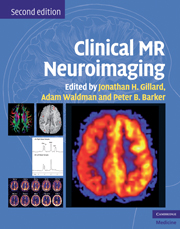Book contents
- Frontmatter
- Contents
- Contributors
- Case studies
- Preface to the second edition
- Preface to the first edition
- Abbreviations
- Introduction
- Section 1 Physiological MR techniques
- Chapter 1 Fundamentals of MR spectroscopy
- Chapter 2 Quantification and analysis in MR spectroscopy
- Chapter 3 Artifacts and pitfalls in MR spectroscopy
- Chapter 4 Fundamentals of diffusion MR imaging
- Chapter 5 Human white matter anatomical information revealed by diffusion tensor imaging and fiber tracking
- Chapter 6 Artifacts and pitfalls in diffusion MR imaging
- Chapter 7 Cerebral perfusion imaging by exogenous contrast agents
- Chapter 8 Detection of regional blood flow using arterial spin labeling
- Chapter 9 Imaging perfusion and blood–brain barrier permeability using T1-weighted dynamic contrast-enhanced MR imaging
- Chapter 10 Susceptibility-weighted imaging
- Chapter 11 Artifacts and pitfalls in perfusion MR imaging
- Chapter 12 Methodologies, practicalities and pitfalls in functional MR imaging
- Section 2 Cerebrovascular disease
- Section 3 Adult neoplasia
- Section 4 Infection, inflammation and demyelination
- Section 5 Seizure disorders
- Section 6 Psychiatric and neurodegenerative diseases
- Section 7 Trauma
- Section 8 Pediatrics
- Section 9 The spine
- Index
- References
Chapter 1 - Fundamentals of MR spectroscopy
from Section 1 - Physiological MR techniques
Published online by Cambridge University Press: 05 March 2013
- Frontmatter
- Contents
- Contributors
- Case studies
- Preface to the second edition
- Preface to the first edition
- Abbreviations
- Introduction
- Section 1 Physiological MR techniques
- Chapter 1 Fundamentals of MR spectroscopy
- Chapter 2 Quantification and analysis in MR spectroscopy
- Chapter 3 Artifacts and pitfalls in MR spectroscopy
- Chapter 4 Fundamentals of diffusion MR imaging
- Chapter 5 Human white matter anatomical information revealed by diffusion tensor imaging and fiber tracking
- Chapter 6 Artifacts and pitfalls in diffusion MR imaging
- Chapter 7 Cerebral perfusion imaging by exogenous contrast agents
- Chapter 8 Detection of regional blood flow using arterial spin labeling
- Chapter 9 Imaging perfusion and blood–brain barrier permeability using T1-weighted dynamic contrast-enhanced MR imaging
- Chapter 10 Susceptibility-weighted imaging
- Chapter 11 Artifacts and pitfalls in perfusion MR imaging
- Chapter 12 Methodologies, practicalities and pitfalls in functional MR imaging
- Section 2 Cerebrovascular disease
- Section 3 Adult neoplasia
- Section 4 Infection, inflammation and demyelination
- Section 5 Seizure disorders
- Section 6 Psychiatric and neurodegenerative diseases
- Section 7 Trauma
- Section 8 Pediatrics
- Section 9 The spine
- Index
- References
Summary
Introduction
Nuclear magnetic resonance (NMR) spectroscopy was demonstrated for the first time in bulk matter in 1945 when Bloch and Purcell independently demonstrated that a strong magnetic field induced splitting of the nuclear spin energy levels, resulting in a detectable resonance phenomenon.[1,2] The method was originally of interest only to physicists for the measurement of the so-called gyromagnetic ratios (γ) of different nuclei, but applications of NMR to chemistry became apparent after the discovery of chemical shift and spin–spin coupling effects in 1950 and 1951 respectively.[3,4] High-resolution liquid state NMR spectra contain fine structure because the resonance frequency of each molecule is influenced by both neighboring nuclei (coupling) and the chemical environment (shift), which allows information on the structure of the molecule to be deduced. Hence, NMR spectroscopy rapidly became an important, and widely used, technique for chemical analysis and structure elucidation of chemical and biological molecules.
Major technical advances in the 1960s included the introduction of superconducting magnets (1965), which were very stable and allowed higher field strengths to be attained than with conventional electromagnets, and in 1966 the use of the Fourier transform (FT) for signal processing. In FT spectroscopy, the sample is subjected to periodic radiofrequency transmitter pulses followed by collection of the signal as a function of time (i.e., a time-domain signal), and the frequency-domain spectrum is calculated by FT. Use of FT NMR provides increased sensitivity compared with previous (so-called “continuous-wave”) techniques, and also led to the development of a huge variety of pulsed NMR methods, including multidimensional NMR techniques.
- Type
- Chapter
- Information
- Clinical MR NeuroimagingPhysiological and Functional Techniques, pp. 5 - 20Publisher: Cambridge University PressPrint publication year: 2009
References
- 1
- Cited by

